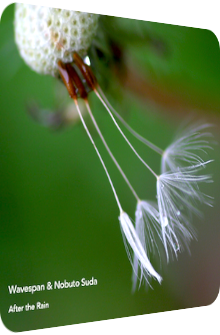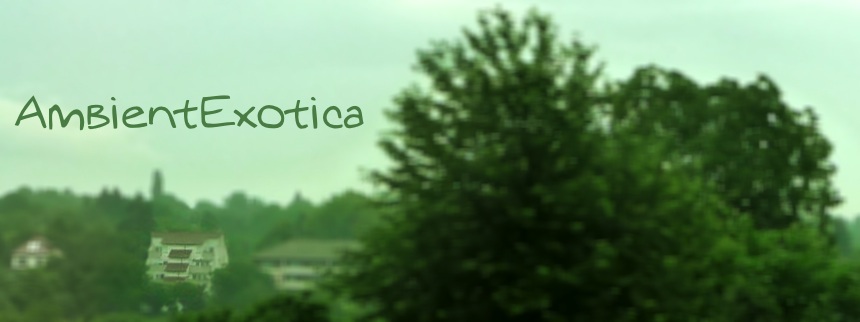
Wavespan & Nobuto Suda
After The Rain
2012
After The Rain is the result of a joint venture between the Santa Cruz, California-based guitarist and Drone producer Phil Garrison aka Wavespan and guitarist and field recordist Nobuto Suda from Kyoto, Japan. With the additional help of Thomas Park aka Mystified who provided an unspecified field recording, percussionist Jason Wehmhoehner, guitarist Gerard Egan and the contribution of a sample from the Rick Jensen Quartet's composition Restless Legs, the duo of Garrison and Suda create a synth-focused, guitar-interspersed work of 37 minutes, released in December 2012 on the Kikapu netlabel where you can download After The Rain for free. Durations of such proportions are not uncommon in the realms of Ambient, but in the last couple of years, the tendency suggests that such long tracks are usually of the progressive, ever-shifting kind and chock-full with varying textures, timbres and sometimes even rhythms. In this regard, Wavespan and Nobuto Suda are refreshingly retrogressive; more about this in a moment. The transpacific collaboration was initiated by Garrison who asked Suda for a few guitar layers and melodies. These were then mixed with the synth aortas and further ennobled by the staggering traits of taiko drum samples. The mood range of After The Rain is not exactly eupeptic, but nonetheless relaxing and embracing with strong doses of carefreeness and contentment. Despite the various layers Suda sent and the many musicians involved in the process of creation, this tune turns out to be strongly circular and fond of the reintroduction of already known sections, a particularity which is not often considered in such a bold fashion nowadays. Two pressing questions have to be answered over this review's course: does this macro-loop structure cause a tiresome and overly repetitive song? And what are the advantages of such an approach, given the duration of over half an hour?
Undoubtedly, the following 37 minutes are going to be intense and varied, as the superstructure of After The Rain shifts, morphs, changes and seems to breathe, but reintroduces all of the elements and ingredients time and again. The composition is less keen on a progressive journey with a definite start or end point because it is actually circular. Its point of departure is decidedly ethereal and earthen, with acroamatic synth streams and fizzling wind gusts coalescing with a seemingly rhizomatic base frame whose impetus, however, is marginalized by the voluminosity of the other strata. Given the focus on and the bold use of the guitars, this prelude is not based on any guitar string, and if it was, Wavespan and Nobuto Suda sure know how to mask the characteristic traits. The synth stream is polylayered, awash with a pristine purity and notably seraphic; despite these descriptions, no synth choir presets are used. The anacrusis ends with the inclusion of a clear cut four-note motif that meshes well with the blissful friendliness of the synth-heavy backdrop. After the fade-out of the melody, the next phase is based on a drone that is played on the same guitar and an additional bunch of polyphonous strings. The aura then shifts and morphs, and decidedly so, for Wavespan unleashes earth-shaking taiko drum samples in adjacency to dualistically mellow-energetic guitar creeks which change back to the known synth structure soon. The first ten minutes have now passed.
The structure of encapsulating synth streams and mellifluous guitar melodies is nurtured another three minutes, before the haze factor increases big time, as does the level of energy, for a structure of electric guitar drones is established. The dreaminess wanes just a whimsical bit, as the esprit of this particular drone layer is soon softened, fades out almost immediately and is replaced with a scintillating Northern light string which whirrs and glows solemnly. Once the guitars stop playing, it is the only element that can be heard, gently oscillating and shuttling between various halftone states, ebbing and flowing thanks to the addition and demise of angelic streams. The taiko drum section returns, then ennobled with Phil Garrison's play on the bass guitar and scents of Glitch particles such as clicks and spluttering droplets. A whitewashed mist rises, and if the beat structure was not in place, eeriness would have ensued for the first time. The beats do indeed fade, but so does the fog which is entangled with the familiar synth placenta and liquedous guitar melodies. The finale of After The Rain relies one last time on the taiko drum and bass accompaniment, spices these things with insectoid clicks, goblet drums and a nocturnal field recording of owls. The composition finishes with a full-circle-movement in the way it began: with the mellowness of the cherubic synth layers, now gently decreasing in volume for their last salute.
After reading the liner notes and the detailed descriptions about the approach of all the musicians involved, one might think that After The Rain is anything but a macro-structure with many vignettes, ideas and concepts that gradually traverse by and make this an aural travelog. The truth, however, is more profane, but nonetheless appealing, even strongly so: After The Rain is loaded with repetitive moments and reoccurring themes which are altogether only slightly altered and ennobled. The inclusion of the taiko drums naturally marks the biggest impact, but after their introduction, they reappear another two times in the very same way. Their excitement and iridescence might have vanished by then, alhough this is, I believe, well-calculated, for they are part of the circle and let the listener concentrate on the microscopic alterations or additions. After The Rain is henceforth more of a real Ambient song instead of an avantgarde collage or hodgepodge of different layers and compositions thrown together in order to entertain the listener with something new on every corner. Even the guitar melodies reoccur several times despite the easiness to come up with new tone sequences or textures. The listener is invited to adjust him- or herself to the arrangement and bathe in the familiarity of the respective element. This expands the level of comfort, but lessens the excitement. In the end, I find it refreshing and honest that Wavespan and Nobuto Suda present such a loop-based Ambient piece, even though the loops themselves should better be called phases or sections. And despite the use of taiko drums, the New Age factor is slim, there is nothing esoteric in the soundscape. After The Rain offers an enchanting sequence of reappearing events and is completely carefree, blissful and surprisingly lofty, given the prospect of its synth-related thickness.
Further listening:
You can listen to After The Rain in full at Bandcamp or download the song for free at the Kikapu label's website.
[Update Mar. 14, 2013: As it is increasingly the case, I have been fooled. There are no synths used in After The Rain. There must be, or so it seems. But no, all these instances are created with cleverly tweaked guitars according to an email from Wavespan. As usual, I leave the original review intact. My misconception only shows the craftsmanship of Wavespan & Nobuto Suda. Instruments with keys and knobs become increasingly obsolete if the progress of mimicry and the constant stream of innovation continues…]
Ambient Review 193: Wavespan & Nobuto Suda – After The Rain (2012). Originally published on Mar. 13, 2013 at AmbientExotica.com.
